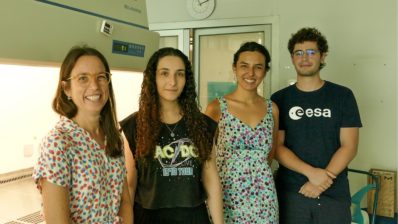Carles Lalueza-Fox has headed up the palaeogenomics lab at the Institute for Evolutionary Biology (IBE: CSIC-UPF) since 2008. The group aims to retrieve and analyse genomes from the past in order to understand evolutionary processes. Lalueza-Fox’s definition of ‘the past’ is very loose: it can be a few decades to tens of thousands of years. “Right now we are looking at a Neanderthal specimen about 170,000 years old”, he explains.
The aim of the paleogenomics lab led by Carles Lalueza-Fox is to analyse genomes from the past in order to understand evolutionary processes.
Studying ancient DNA presents certain difficulties, including its degradation. The percentage of DNA sequences that truly belong to the sample in respect to the total number of recovered sequences (the so-called ‘efficiency’ of the sample) is very low in the south of Europe, in part due to unfavourable thermal conditions. “In the majority of Neanderthal, Neolithic and mammoth samples found in the Iberian Peninsula, the endogenous DNA sequences are less than 1%. The rest are bacterial”, explains Lalueza-Fox. This makes it complex and expensive to recover DNA, because it is necessary to sequence a lot of it. “I always say that I was born in the wrong place. Siberia would have been better”, jokes the scientist.
To overcome this difficulty, the group tries to study samples with the greatest efficiency possible. “A little while ago we managed to retrieve a tooth from the first European hunter-gatherer that had 50% efficiency. This enabled us to carry out an analysis and we showed that, surprisingly, he had dark skin and blue eyes“, says the head of the group. When, despite everything, efficiency is low, they use “capture” techniques to make it easier to identify this endogenous 1%.
The closest prehistory
The new massive sequencing technologies facilitate contamination control, and have permitted scientists to recover genomes from our closest prehistory. “My interests are moving towards the Mesolithic, the advent of agriculture, and the Bronze Age. Interestingly, these have been looked at less than Neanderthals, although they are more recent”, explains the head of the group.
The new massive sequencing technologies facilitate contamination control, and allow scientists to recover genomes from our closest prehistory.
There are many cultures defined archaeologically that have not been studied at the genetic level. Doing this could give us clues as to how they arose. For example, the Bell-Beaker culture, who made bell-shaped ceramics, are found from Germany to Portugal. The group is analysing samples of individuals buried in different places across Europe where this kind of ceramic is seen. If they are more similar to each other than to the present day populations in these areas, the emergence of this culture throughout Europe can be said to be due to migratory movements, and not an expansion of ideas.
Diversity of projects
Recently, an analysis carried out in the laboratory has debunked the theory that a 200 year old smear of blood belonged to Louis XVI. And now they are analysing bones from a cemetery in Quebec that could be from the small town of founders who arrived in the 17th century. The analysis of this genome is interesting at a biomedical level because there are serious Mendelian diseases present in Quebec that are very uncommon in other parts of the world.
According to the researcher, imagination is the only limit to what you can study. “A few weeks ago I went to the El Castillo cave to sequence a 45,000-year old cave painting. They used to blow the pigment using their mouths and I figured that if there was saliva, I could get the DNA and we could find out who did it. There are people who believe that they were made by Neanderthals rather than modern humans. It’s crazy, but I’m curious!” he confesses.
The group is one of four laboratories in the world that has sequenced complete ancient genomes.
The group from the IBE is one of four laboratories in the world that has sequenced complete ancient genomes. In addition, Lalueza-Fox has written several popular science books. The researcher is passionate about his job and that is why he writes about it, but he has other reasons: “I think that there is a certain moral duty on the part of the scientists who work on human evolution and diversity to talk about these issues, due to the number and strength of the stereotypes and prejudices there are.”
You can hear Lalueza-Fox talking about his research in this video:







